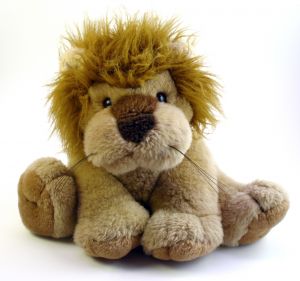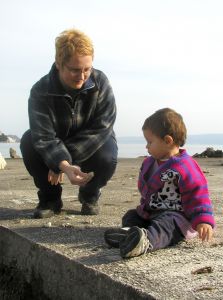By Tamara Brennan
 Sooner or later, in every child’s life, it’s bound to happen. For my tender child, unexpected rejection came from her very first friend and before her third birthday. Clarisa and her shadow, little sister Antonia, live on the other side of a wire fence just outside our kitchen in southern Mexico.
Sooner or later, in every child’s life, it’s bound to happen. For my tender child, unexpected rejection came from her very first friend and before her third birthday. Clarisa and her shadow, little sister Antonia, live on the other side of a wire fence just outside our kitchen in southern Mexico.
As soon as Nicole could walk, she would stand at the fence and call out to the little girls. To her great delight, they would come and together they’d enter the magic bubble of little girl friendship. Early on, Niki was so thrilled to have contact with other children that she ran into the house for her best toys to pass to them through the fence. For a long time to a short life, the girls were her most treasured friends. She gave the oldest friend the nickname “Coliflor,” cauliflower in Spanish.
Every morning, Nicole gleefully raced over to the fence to call Coliflor out of her house, the unbuttoned lower parts of her pajama top flapping like the mudflaps on a semi-trailer as she bounced through the long grass.
Heartbreak
Suddenly one day, as I watched from the kitchen, my forlorn child called over and over to the children who refused to look her way. The chill that began that day never warmed up. The family on the other side of our fence has had its share of challenges with alchoholism and even child abuse. This friendship was not to be, and my Niki was crushed.
“Coliflor no habla,” (won’t talk to me), she would say over and over all day long for days. Not wanting to slap a “mean-girl” label on the kid, I instead modeled how one sees beyond the hurt toward understanding that sometimes people are complicated. I told her that the girls might have a tummy ache to buy time while hoping they’d come around. Regrettably, a talk with their mom confirmed that, yes, people are complicated.
Healing Takes Time…and Patience
Every afternoon, my daughter and I go on a walk at the urging of our dog Gandhi. Days after the Coliflor freeze began, we came upon a little girl sitting in front of her house. “Well hello!” I, the eager mama, said. Niki refused to come out from behind my legs. After a brief chat, Yaremi ran to get her favorite toys to show Nicole. But my wary child would not go near this unfamiliar short female person. After all, there was not even a fence for protection. The little girl was persistent and engaging, so eventually Niki loosened her grip on my legs and ventured a little closer.
The next day we went back. This time, three little girls rushed over to Nicole like a group of eager puppies. Despite my reassurances, she dashed up the street a safe distance and hugged her dolly like a shield over her heart. Fortunately, the urge to bond and play was stronger than her memory of being shunned. After a couple more afternoon meetings on that street, the warmth started to thaw her reflexive need to protect herself.
As we walked home, I would ask her to tell me the story of her experience with these new girls. One afternoon, I tried to find my way to the most tender point of hurt in my daughter’s heart, so I could better read the questions floating above the accident scene where her innocence had been damaged. As we made our way home past the familiar landmarks, she covered her ears as we reached the angry dog that always barked ferociously from the roof as we passed. Rounding the corner, the friendly street dogs swarmed around us saying their hellos. We knew all the dogs from so many walks and even had names for them. Then it hit me.
“Honey, when we walk, we go past all kinds of dogs. There’s Barky! She’s so loud and she scares us. But you know what? There are other dogs: Dirty-happy dog, Sleepy dog, Blackie, Little guy, and all the others that we know. Of all those dogs, only one is scary, only one. All of the rest say ‘hi’ and want to play with Gandhi. One barky dog and lots that want to play. And it’s the same with little girls!” After some silence, she stopped walking and looked at me. I knew I was on sacred ground.
Healing through Song
This new insight begged for its own song. Ours has grown into an epic with many verses, shifting lyrics, and a mixture of English and Spanish. Its healing power comes from it’s evolving form.
In the parade of little girls, there are many little girls,
Happy ones, friendly ones, cutie ones, bouncy ones
Lots of little girls.Coliflor no habla, adiós Coliflor.
No habla, no habla, adiós Coliflor.
I wish you a happy life.
I hope you never get a tummy ache.
I have to go now and play with my new friends.
For days, Nicole would make the request, “Mama sing the Coliflor part,” over and over as it goes with little minds working to get used to a new idea. So I’d sing at breakfast while we could hear the neighbor girls playing near our kitchen and throughout the day.
One day, we went to get Yaremi to come play at Nicole’s house. Niki skipped with delight beside her friend as we walked up our hill. The song grew new verses and old parts shifted to accommodate new experience.
Yaremi is my friend; she comes to my house,
And we play with my crayons and we play on my swing,
And we eat yummy soup and we…Cayla is my friend. She lives in Guatemala.
She comes to my house and she sits in my chair.
Adios Coliflor.
Cayla is my friend.
The other morning, as the sun rose over the mountain and reached into our house, we were awakened to Nicole singing her song. The last verse ended with a list of her friends and the most lovely line: “I have all my new friends, and I’m really, really happy!” In the dawn’s gentle light, my heart burst out in a song of its own.
Today at lunchtime, I asked Niki about her progress toward finishing her meal. “Sweetie, are you eating your veggies?” I asked. Grinning, she held up a piece of cauliflower and blessed me with one of those classic, little child jokes, “Mommy, Adios Coliflor!”
 One of the hardest situations I face in my household is when one of my children hurts the other one, whether by accident or in play or out of anger. My knee-jerk reaction is to tell the offender to say sorry to her sister, just as my parents had me do when I was younger. My mom would tell me to say sorry and if I did it quickly to get it over with but didn’t really want to say it, she’d say, “Say it like you mean it.”
One of the hardest situations I face in my household is when one of my children hurts the other one, whether by accident or in play or out of anger. My knee-jerk reaction is to tell the offender to say sorry to her sister, just as my parents had me do when I was younger. My mom would tell me to say sorry and if I did it quickly to get it over with but didn’t really want to say it, she’d say, “Say it like you mean it.” A part on our dishwasher broke. I spread a towel on the counter and washed the dishes by hand, laying them on the towel to dry. While I was washing, my 23-month-old son wandered in to see what I was doing. Seeing the towel hanging over the counter, the temptation was too much for him. He grabbed the towel and started to pull.
A part on our dishwasher broke. I spread a towel on the counter and washed the dishes by hand, laying them on the towel to dry. While I was washing, my 23-month-old son wandered in to see what I was doing. Seeing the towel hanging over the counter, the temptation was too much for him. He grabbed the towel and started to pull. We’ve all seen it – a mother losing her temper toward her child in the grocery store, or a father treating his child in a detached, ignoring or even hostile, way at the park. What should we do? What do we say? Perhaps the parent is usually loving and understanding and is just having a tough time at this moment. Or, maybe this is the parent’s standard response to his child.
We’ve all seen it – a mother losing her temper toward her child in the grocery store, or a father treating his child in a detached, ignoring or even hostile, way at the park. What should we do? What do we say? Perhaps the parent is usually loving and understanding and is just having a tough time at this moment. Or, maybe this is the parent’s standard response to his child. Susie Walton used to yell at her kids – a lot.
Susie Walton used to yell at her kids – a lot. My dear crying baby,
My dear crying baby, Parenting during the teenage years is as trying on the young adult as it is on his parents. But if your child was adopted or if you’re fostering, the teenage years can be an especially tough time as your child tries to sort out his identity without knowing his birth parents or understanding the reasons why his birth parents are not a bigger part of his life.
Parenting during the teenage years is as trying on the young adult as it is on his parents. But if your child was adopted or if you’re fostering, the teenage years can be an especially tough time as your child tries to sort out his identity without knowing his birth parents or understanding the reasons why his birth parents are not a bigger part of his life. I don’t encourage the use of lovies – blankets, teddy bears, or other objects children can develop an attachment to – in my household but I don’t discourage it, either.
I don’t encourage the use of lovies – blankets, teddy bears, or other objects children can develop an attachment to – in my household but I don’t discourage it, either. Research has, for many years, shown that the way a child is parented will physically shape his brain — that each interaction, good or bad, will create pathways within the brain as a reflection of the emotions surrounding that interaction. And that a pattern of neglect or abuse will shape the brain differently than will a consistently loving, attachment-promoting relationship.
Research has, for many years, shown that the way a child is parented will physically shape his brain — that each interaction, good or bad, will create pathways within the brain as a reflection of the emotions surrounding that interaction. And that a pattern of neglect or abuse will shape the brain differently than will a consistently loving, attachment-promoting relationship. Through Attachment Parenting, we learn how truly powerful a close emotional relationship with our children can be. But even with the strongest of bonds, conflict will arise between parents and their children. As children grow, AP focuses more and more on how we, as parents, resolve conflict — in a gentle, positive manner that promotes influence, guidance, and teaching rather than control.
Through Attachment Parenting, we learn how truly powerful a close emotional relationship with our children can be. But even with the strongest of bonds, conflict will arise between parents and their children. As children grow, AP focuses more and more on how we, as parents, resolve conflict — in a gentle, positive manner that promotes influence, guidance, and teaching rather than control.